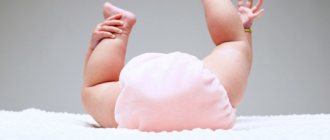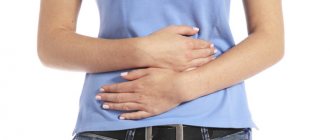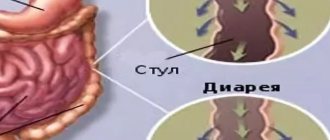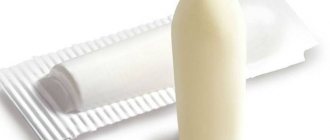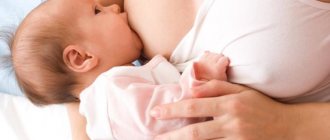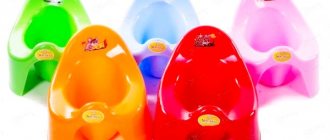The digestive system of a newborn baby is adapted by nature to digest breast milk. During lactation, along with mother's milk, the baby receives beneficial bacteria necessary for the formation of proper intestinal microflora. When formula is introduced into an infant's diet, parents notice that the appearance and frequency of bowel movements change. It is important to understand why loose stool appears in a mixed-fed baby and what to do about it.
Normal stool during mixed feeding
If the baby is fed only by the mother's breast, the frequency of bowel movements in the first month of life ranges from 4 to 12 times a day. The consistency of stool in this case is quite liquid, because breast milk consists of 90% water. The digestive organs are still poorly formed, the production of enzymes is not established, the food consumed quickly goes through the digestion process and is excreted naturally. Artificial milk formulas contain proteins that are more difficult for a fragile body to digest. Loose stools or constipation in a newborn with mixed feeding are a common occurrence.
Any changes in the infant’s diet (introduction of complementary foods or replacement of breastfeeding with artificial formula) will result in a change in the appearance of feces. The normal frequency of bowel movements is half that of breastfeeding, from 2 to 6 times a day, and the consistency becomes denser, resembling a thick ointment or paste.
Feces after birth
During the period of intrauterine development, the child fed through the umbilical cord, and not through the mouth, but despite this, he already made swallowing and sucking movements. As a result, skin flakes, villi, and amniotic fluid entered his intestines. However, all these substances only accumulated in the body and were not excreted in any way.
On the first day after birth, beneficial bacteria populate the baby’s intestines and begin to actively remove everything unnecessary from it. As a result, the baby’s first stool, meconium, is released. Don't worry if you notice green or black stool in your newborn, which has a consistency similar to plasticine. This is a normal phenomenon; such feces are excreted for two days. When your baby begins to breastfeed regularly, the appearance of stool will change.
Causes of diarrhea during mixed feeding
The causes of diarrhea in a mixed-fed baby are quite varied and depend on several factors:
- Unbalanced nutrition of a nursing mother. Remember: everything that a mother eats, her baby also receives with milk. Fatty, fried, smoked foods should be excluded from the menu during breastfeeding.
- Infant overeating. It's no secret that breastfeeding is a more labor-intensive process than absorbing formula from a bottle. The hole in the nipple has a larger diameter than the breast ducts; through it it is easier and faster to obtain a volume of milk exceeding a single dose. The baby's digestive system is not adapted to large portions, and malfunctions in the absorption of food can often be observed. Don't try to fit your feeding schedule to any specific schedule. Feed your baby on demand, let him get hungry - then you will be sure that the entire volume of milk received earlier has been completely absorbed.
- Individual intolerance to the mixture. The composition of artificial nutrition may differ from one manufacturer to another. Some ingredients can cause allergic reactions in the baby, manifested by diarrhea.
- Period of tooth growth. Teething becomes a common cause of diarrhea in infants. The child tries to scratch the itchy gums and puts everything that comes to hand into his mouth. Many objects contain pathogenic bacteria that disrupt the composition of the intestinal microflora. Loose stool lasts 3-5 days and is accompanied by obvious symptoms - restlessness, sudden crying, profuse drooling.
- Intestinal infections. Pathogenic bacteria, entering the body, begin to actively multiply and release toxins. Green stools appear more frequently, with inclusions of mucus, and the temperature rises. Such conditions require contacting a doctor for qualified help.
Treatment methods for the condition
Diarrhea that occurs in a baby during mixed feeding provokes fluid loss. Methods of providing assistance for such disorders come down to stopping diarrhea and replenishing the water-salt balance of the body:
- If possible, put the baby to the breast more often - mother's milk can replenish lost fluid, maintains the necessary microflora in the digestive tract, and contains beneficial lactic acid bacteria that suppress the growth of pathogens.
- Provide your baby with plenty of fluids - boiled water in frequent small doses, as well as pharmaceutical saline solutions (Regidron, Oralit, Glucosolan). In emergency cases, when it is not possible to purchase medications, it is not difficult to make an analogue of a pharmaceutical saline solution at home. To one liter of warm boiled water add 2 tablespoons of granulated sugar, one teaspoon each of regular table salt and baking soda, mix thoroughly until the dry ingredients are completely dissolved. Cool the finished solution to a temperature of 37 degrees - this way the product will be absorbed faster.
- The drug “Smecta” is successfully used to treat diarrhea. It adsorbs and removes toxins from the body, coats the intestinal walls, and reduces irritation of the mucous membrane. Available in powder form, packaged in sachets. The contents of 1-2 sachets are dissolved in any liquid product in a bottle and given in several doses throughout the day.
- Until a mixed-fed baby stops diarrhea, vegetable complementary foods are excluded from his diet. During this period, it is necessary to balance the diet of the nursing mother and remove all irritating, gas-forming foods from the menu. Frequent changes of milk formula are not recommended - a fragile body does not tolerate new types of food well.
- Elevated body temperature aggravates dehydration and requires the use of antipyretic drugs. In severe cases, antibiotic therapy is carried out. But remember that not all medications are approved for young children. Only a doctor should prescribe medications and determine dosages!
Digestion during fetal development
When a baby is in the womb, all nutrients reach it through the placenta. For this reason, the fetus's digestive organs develop but do not function until birth. Before birth, the baby’s gastrointestinal tract is sterile, that is, there are no microorganisms in it. During passage through the birth canal, the digestive system is populated by the first bacteria that form the intestinal microflora.
In the first 24 hours after birth, the baby eats colostrum, which contains a large number of bifidus factors. Thanks to this substance, bifidobacteria rapidly multiply in the digestive tract of a newborn, which has a beneficial effect on intestinal function. It is the beneficial bacteria that start the baby's gastrointestinal tract. After becoming familiar with this process, you can consider how the child’s stool looks and changes.
When to see a doctor
Young parents should carefully assess their child's condition. Reasons to be wary and contact a pediatrician are:
- frequent (more than 8-10 times a day) sudden bowel movements;
- a large amount of mucus in the stool;
- profuse vomiting “fountain”;
- increased body temperature;
- the appearance of a rash on the body;
- feces of an unusual color - green, black, foamy, or mixed with blood;
- refusal to eat, crying, restless behavior;
- signs of dehydration - dry skin, retraction of the fontanelle, decreased amount and darkening of urine.
Green feces may indicate the development of dysbiosis. To confirm the diagnosis, it is necessary to take an additional stool test - a coprogram. A child with dysbiosis should be treated with drugs that restore the normal flora of the digestive tract.
An intestinal infection is accompanied by abdominal pain, colic, and flatulence. Body temperature often rises, sometimes to high values. Diarrhea can continue for a long time, the baby’s condition worsens, drowsiness and lethargy appear.
Feces from 3 to 10 days of life
On the third day after birth, transitional feces are released, which have the following distinctive features:
• pale yellow or mustard shade; • heterogeneous consistency (sometimes); • stool with greenish elements (meconium residues in the intestines); • liquid or mucus may be present in the bulk; • loose stools with a pasty consistency; • feces with a sour or sweetish odor; • small lumps.
All of the above features are a variant of the norm in the period from 3 to 10 days. This appearance is due to the fact that the formation of intestinal microflora and the adaptation of the digestive tract to breast milk are completed.
Possible complications and prevention
The most serious complications of diarrhea are dehydration of the baby and weight loss. Along with the liquid, salts and trace elements important for life are lost, which can provoke convulsive conditions.
The causative agents of intestinal infections actively multiply and release toxins that poison the body.
Disturbed microflora interferes with the absorption of nutrients, inhibits weight gain, muscle growth and the proper development of internal organs.
Prevention of diarrhea comes down to the following rules:
- Compliance with sanitary and hygienic standards during mixed feeding. Wash your hands thoroughly, sterilize dishes for preparing baby food, bottles and pacifiers. The finished mixture should not be stored for more than an hour; it is better to use it immediately after preparation.
- Monitor the freshness and quality of products intended for the baby and nursing mother.
- Artificial nutrition should not be changed frequently - manufacturers use different ingredients for their products. A baby's fragile digestive system may react painfully to new components, even leading to the development of an allergic reaction.
In general, it is not difficult to distinguish loose stools as a normal variant from a painful condition. If your baby looks healthy and calm, eats willingly, is gaining weight, and is active, then there is no need to worry. With age, digestion will improve and stool will return to normal.
A baby is an inexhaustible source of happiness and no less a cause for concern. Since the child cannot tell his mother that he is in pain, it is necessary to carefully monitor the condition of the child’s body in order to prevent diseases. One of the most difficult diseases in terms of early diagnosis is diarrhea in newborns.
Usually, babies defecate loose stools for up to six months, so it is difficult for young parents to determine if the baby is healthy or if there is diarrhea.
Constipation symptoms
When do parents need to take action? It is believed that a child has constipation if the following symptoms are observed:
- stool is too hard, shaped or pea-shaped;
- the stool has a putrid aroma;
- when trying to poop, the baby strains and strains a lot;
- the child writhes his legs, groans and cries;
- baby's belly is hard and swollen;
- the baby loses his appetite;
- He has stool less than once every 3 days.
How to determine diarrhea in a newborn
The normal stool for infants is a mushy substance with a uniform consistency without foreign impurities. The color is yellowish-brown, the smell resembles slightly sour milk. Changing these criteria is possible not only with the development of gastrointestinal diseases, but also if the mother changes habits. For example, he introduces other foods into his diet.
If the baby eats calmly, his behavior does not change, most likely, changes in stool are caused by new substances in breast milk. If your child begins to be fussy after eating, consult a specialist. Only an experienced pediatrician can diagnose diarrhea in an infant with 100% certainty, and the following signs are reasons for an urgent visit to the doctor:
- the baby defecates more or less often;
- stool became more intense and abundant;
- there was a smell of putrefaction;
- there is a large amount of cheesy inclusions or diarrhea with mucus has appeared;
- color has changed: the stool has become green or dark brown;
- the consistency has changed: the stool has become harder or diarrhea with water is observed.
Note! Liquid stool is absorbed into the diaper, so there is a risk of missing the disease in the newborn. If there are no signs of diarrhea (and yellow diarrhea can easily be confused with normal bowel movements), but the baby’s behavior has changed and he is capricious when eating, do not use a diaper for a while to make sure there is no illness.
Any of the above symptoms may indicate either diarrhea in a newborn or less serious disorders of the digestive system. Consult with your doctor to avoid causing illness and harm to your child’s health.
Medications
As for laxatives, without consulting a specialist, a well-known pediatrician considers only two categories of such drugs acceptable:
- Liquid oils, such as olive, castor or almond oil.
- Preparations based on senna, for example, senade or senadex.
When giving a child these remedies, the main task is to achieve daily bowel movements (preferably in the morning, so the drugs are recommended to be taken before bedtime). The dosage should be selected so that going to the toilet in the morning does not cause discomfort.
If you increase the dose to the maximum allowable, at the same time change the child’s diet, do not overheat him and give him enough fluids, as well as foods with potassium, and all these actions do not eliminate constipation in three days, you should go to a specialist.
Having selected the current dose of the laxative, give the child the drug in such a dosage for 10-14 days, so as not only to make the baby’s bowel movements regular, but to develop the reflex to have a bowel movement at the same time every day. Then gradually reduce the dose every three to four days, and if constipation appears again, give the child the same amount of medicine.
Komarovsky emphasizes that constipation, like any other health problem, should be treated comprehensively.
Causes of diarrhea in a newborn
There are many factors that cause acute intestinal upset, most of them are related to the baby’s diet, but there are other reasons that cause diarrhea. We propose to understand how breastfeeding, artificial and mixed feeding affects stool and what factors can influence the onset of the disease.
Diarrhea when bottle feeding a baby
A balanced diet that fully corresponds to breast milk in artificial formula is a publicity stunt. Even expensive formulas cannot 100% recreate natural nutrition, since each mother and child are individual. Diarrhea in artificial infants occurs due to:
- Inconsistencies between the mixture and the physiological characteristics of the baby. The result: incomplete digestion of food, stomach rejection and greenish stool interspersed with curdled food.
- Using mixtures that are not age appropriate. Lack and excess of nutrients in complementary foods equally harms the body, which reacts with indigestion and diarrhea.
- Insufficient utensil hygiene. Even a super-careful mother will not be able to completely sterilize the room. Microorganisms that are invisible to the eye remain and enter the newborn’s stomach from a pacifier or bottle.
- Poisoning. Not every parent carefully studies the expiration date of the product, and using expired formula is a guarantee of a negative reaction from the child’s body.
With artificial feeding, the emotional connection between mother and baby decreases, so diarrhea can be caused by a lack or excess of emotions.
Why does breastfeeding disorder occur?
The close relationship between mother and baby is especially evident during natural feeding. Mother's milk is a source of all essential nutrients, vitamins and minerals. It can also cause diarrhea in a newborn. Diarrhea occurs if:
- The nursing mother ate food that promoted laxity. Consumption of kefir, sour cream, watermelon, plums, zucchini, and beets affects the composition of milk. The baby receives a natural “laxative”, the body reacts with diarrhea. Usually the phenomenon disappears as soon as the mother eliminates laxative foods from the diet.
- The child is allergic to certain foods. Most often, fragile immunity reacts to the same allergens as the parent organisms. If there is an individual intolerance to any food in your family, exclude it from the nursing woman’s menu so as not to provoke an allergic reaction and save the baby from diarrhea.
- Dysbacteriosis has developed. Usually the disease is provoked by the mother taking medications or due to metabolic disorders in the child.
- The baby got poisoned. Poisoning occurs not only as a result of the mother taking the “wrong” foods. Such a process can be “started” by the not yet formed pancreas. The lack of iron enzymes does not allow the fragile body to cope with incoming food. This results in nausea, upset stomach, diarrhea with mucus and an unpleasant odor, and sometimes vomiting.
Important! If you observe symptoms of diarrhea while breastfeeding, be sure to show your baby to a specialist. It’s good if the treatment consists of a special diet for the mother. Sometimes such signs may indicate a serious intestinal infection that requires special treatment.
Diarrhea in a newborn with mixed feeding
With a mixed diet, a child may develop diarrhea for any of the above reasons. However, there is a peculiarity - babies with such feeding react sharply to the change from mother's milk to formula with watery stools.
Why is diarrhea dangerous in infants?
The danger of diarrhea is dehydration of the body, which leads to disruption of the functioning of all vital systems. In the first year of life, the following signs indicate dehydration due to loose stools:
- the child eats normally, but does not gain weight, and sometimes even “loses” the kilograms already gained;
- the baby is lethargic, does not want to play, demands to be carried;
- infrequent urination, the color of urine changes from light to dark;
- there is a retraction of the fontanel and its increased pulsation;
- the skin becomes dry and warmer.
Important! Babies 1-2 months cry without tears (the tear duct is undeveloped). However, if the eyes of a baby 2 months of age and older remain dry when crying, he is not “drooling” - we are talking about dehydration. If abnormal bowel movements are observed, both diarrhea and dehydration should be treated immediately.
Methods for treating diarrhea in infants
“What to do and how to treat diarrhea in a newborn?” - a common question among young parents. Treatment is the prerogative of a specialist. However, the mother will not wait for the doctor, looking at how the child is suffering.
The best way is to consult a doctor by phone and take measures against dehydration (make sure you drink). Depending on the cause of the disorder, the pediatrician may prescribe:
- Absorbents that improve intestinal function and relieve painful symptoms. For example, "Espumizan Baby". For babies up to 1 month, Smecta for newborns is suitable.
- Bifidumbacterin, if diarrhea occurs quite often. This medicine can be given for diarrhea by dissolving it in milk or formula and giving it half an hour before feeding.
If the diarrhea is infectious or bacterial in nature, you will have to undergo a course of antibiotic therapy. Stopping diarrhea by other means simply will not work, since the pathogenic flora is reluctant to leave the affected body. Usually, to suppress pathogenic intestinal microorganisms, Levomycetin, Furazolidone or Nifuroxazide are prescribed in a “children’s” dosage, in accordance with the age of the baby.
What medications can be used in infants for constipation?
It is not recommended to give babies any medications without consulting a doctor. Even the safest drugs approved for use from birth can harm the immature intestinal microflora of a child. Therefore, only in extreme cases is it recommended to use medications to cure constipation in infants.
- It is best to use preparations containing lactulose. This is the safest laxative. Lactulose syrup is a prebiotic. It stimulates the production of beneficial bacteria in the intestines and helps remove feces. The following drugs containing lactulose are recommended: Duphalac, Normaze, Portalak, Lizalak and some others. To begin with, it is better to give these medications in a reduced dosage. And if you need long-term use, you should definitely consult your doctor.
- To reduce gas formation in the intestines, doctors prescribe the following drugs to children: Espumisan, Plantex or Sub-Simplex. They help relieve cramps and gently remove gases, relieving bloating.
- Komarovsky considers glycerin suppositories to be the best remedy for constipation in infants. Children's ones are very rarely sold on sale, but regular ones can also be used. One candle needs to be cut in half lengthwise and then crosswise. You will get four parts. You need to smooth out all the edges of one piece of candle with clean hands and carefully insert it into the baby’s anus. Gently squeeze his buttocks and hold for a while. This suppository will help soften stool and gently move it out.

